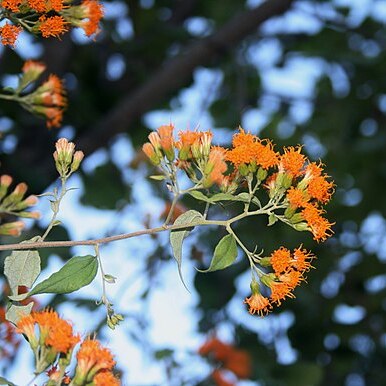Scrambling shrub 1.2-9 m high, deciduous, lax, usually ± scandent; stems at first white-tomentose, glabrescent; sometimes flowering before the leaves develop.. Leaves subcoriaceous, (broadly) elliptic or ovate, 2-12 cm long, 1-5(-10) cm wide, base cuneate to subtruncate and decurrent, margins entire or remotely ± dentate, apex acuminate, apiculate, glandular on both surfaces, green and glabrescent or glabrous above, paler and finely pubescent (especially along the veins) but glabrescent beneath, strongly 3-veined from near the base; petiole 0.5-2 cm long.. Capitula numerous in dense terminal compound corymbose cymes; stalks of individual capitula densely white-tomentose; involucre obconic to subcylindric, 3-7 mm long; phyllaries 5-6-seriate, lanceolate to ovate, 1.5-6.8 mm long, the outermost shortest, acuminate-apiculate, pale green, tomentose on the margins.. Flowers sweet-scented; florets up to 30 per capitulum; corolla golden yellow to orange-red, 7-10.2 mm long, lobes 1.7-2.5 mm long, glabrous.. Achenes obscurely ribbed, 2-3.3 mm long, ascending-pubescent, glandular; outer pappus of very narrow scales, 0.3-1.5 mm long, inner pappus pale stramineous or tawny, 5-7 mm long.. Fig. 35.
Scandent shrub. Leaves glabrous or sparsely pubescent, triplinerved, margins entire. Outer pappus of very short, narrow scales, inner of long, scabrid bristles. Heads usually with 3-7 flowers. Achenes hairy. Flowers pale yellow or creamy white; December and April to July.

